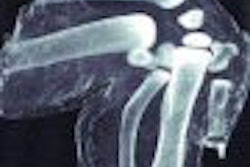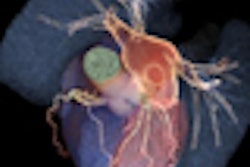Radiologists aren't the only ones who must grapple with contrast-induced allergic reactions: Endovascular therapy specialists may see their choices for imaging exams limited by issues such as contrast-induced nephropathy and hypersensitivity to gadolinium, according to an imaging expert from Columbia University.
"Patients need imaging so we can perform our procedures, but contrast is a potential problem," said Dr. John Rundback, during a talk at the 2008 Annual International Symposium on Endovascular Therapy (ISET) meeting in Hollywood, FL. "Contrast-induced nephropathy substantially impacts the way that we approach these patients and clearly has an impact in terms of how we utilize contrast."
"Hypersensitivity to contrast, renal insufficiency, and this issue with nephrogenic systemic fibrosis (NSF) is limiting our ability to use gadolinium to evaluate patients," added Rundback, an associate professor of clinical radiology at Columbia University in New York City. "So what are the solutions? How do we get around this sort of problem?"
Rundback offered some options. Of course, Rundback recommended either forgoing gadolinium-enhanced MRI or choosing low osmolar contrast media in patients with renal insufficiency. For those with other contrast-related problems, he suggested carbon dioxide (negative contrast) angiography. "Certainly, intravenous ultrasound hemodynamic measurements can be done without any iodated contrast," he added.
Rundback was particularly enthusiastic about the use of hydration and targeted renal therapy agents that can be employed to decrease the risk of contrast reactions without sacrificing imaging quality.
"We can give agents directly into the target organ most affected, namely the kidneys, and therefore in a very selective fashion, which is what we do predominantly as interventional radiologists, limit the injury related to contrast," he explained.
He cited the results of the Benephit System Renal Infusion Therapy (Be-RITE) trial as an example of successful targeted renal therapy (TRT). For this trial, sponsored by FlowMedica of Fremont, CA, 501 patients at 17 U.S. and international centers were enrolled. Among them, 90% had chronic renal disease and about 80% received TRT while undergoing diagnostic coronary angiography and/or intervention, as well as peripheral angiography. Infusing agents used included fenoldopam mesylate, sodium bicarbonate, and alprostadil.
At the 2007 Society of Interventional Radiology (SIR) meeting in Seattle, researchers involved in the trial reported that using TRT resulted in a drop in the incidence of contrast-induced nephropathy from 29% to 9% in an early patient population of 150 people. The Be-RITE trial closed in August 2007, and according to the final results, bilateral renal artery cannulation was accomplished in 96% of patients, requiring an average of 8 cc of contrast media for placement.
"The accepted dose of at least 0.4 mcg/kg/min (of TRT) for a duration of at least one hour may provide an even greater reduction in the incidence of contrast-induced nephropathy in these patients," Rundback said. He called the Be-RITE result encouraging, but added that additional studies were needed to confirm them.
By Micheal Casasnovas
AuntMinnie.com contributing writer
February 19, 2008
Related Reading
Study offers more evidence that multiple factors up NSF risk, January 24, 2008
'Uniquely higher' relaxivity rates give gadobenate an edge, January 23, 2008
Studies outline techniques for ramping up MR in renal artery imaging, January 10, 2008
Sodium bicarbonate best for prevention of contrast-induced nephropathy, October 29, 2007
Copyright © 2008 AuntMinnie.com



















